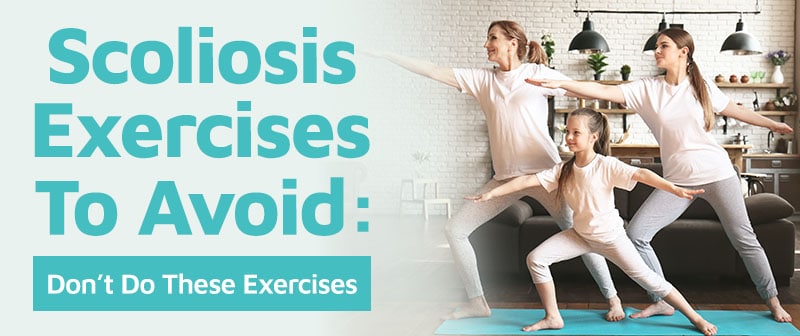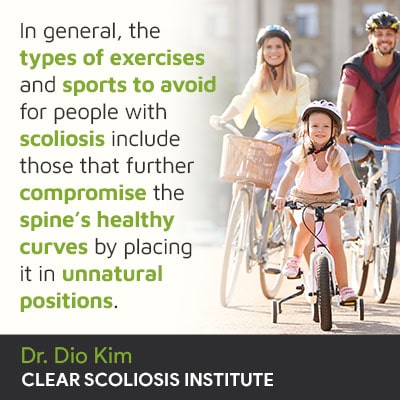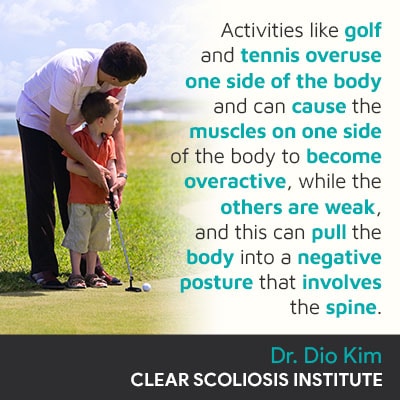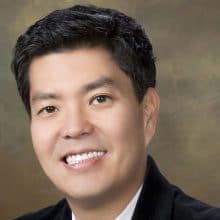
There was a time when the place of exercise in scoliosis treatment was questioned, but as our understanding of the condition, and how it responds to treatment, has evolved over the years, so too has our understanding of how beneficial scoliosis-specific exercises can be, versus general physical therapy exercises.
Scoliosis exercises to avoid would include general exercises that are ineffective because they are not scoliosis-specific, and those that can exacerbate the condition by playing into its asymmetrical effects: overusing one side of the body, straining the spine, or arching the back unnaturally.
Before getting into the specifics of what types of exercises should be avoided by people with scoliosis, let’s first talk generally about the role of exercise in scoliosis treatment.
As mentioned, the role of exercise in scoliosis treatment has been questioned, but many of these doubts were based on research concerning the efficacy of general physical therapy exercises, and not scoliosis-specific exercises (SSEs).
To be clear, there is no exercise, or exercise program, that can achieve corrective results on its own, but when integrated into a proactive treatment plan that combines multiple treatment disciplines, SSEs can help augment corrective results.
People with scoliosis have an unnatural sideways spinal curvature, with rotation, and as a progressive condition, effective treatment has to include correcting the abnormal curve by reducing it, while staying ahead of the condition’s progressive nature.
As a CLEAR-certified scoliosis chiropractor, I adhere to the CLEAR scoliosis treatment protocols that involve customizing each and every treatment plan by apportioning multiple treatment disciplines that impact the condition on multiple levels, including the beneficial nature of SSEs.
In addition to the fact that there are different types of scoliosis with varying underlying causes, scoliosis is a highly-variable condition that ranges from mild to moderate and severe; the complex nature of scoliosis necessitates the customization of effective treatment plans.
To treat scoliosis effectively, I value a chiropractic-centered conservative treatment approach that integrates multiple forms of treatment so the condition can be impacted on multiple levels, but each discipline is scoliosis-specific to produce the most specific and effective results.
While there are no treatment guarantees, through chiropractic care and advanced chiropractic adjustments, I can work towards reducing a scoliotic curve by adjusting the most-tilted vertebrae at the apex of the curve back into alignment with the rest of the spine, thereby reducing the curve.
Particularly for young patients who have not yet reached skeletal maturity, corrective bracing can complement the corrective results achieved through chiropractic care by pushing the spine into a corrective position.
While sit ups and pelvic tilts are scoliosis exercises to avoid, mainly because they are too general to impact scoliosis specifically and arch the back unnaturally, when performed as prescribed, scoliosis-specific exercises and stretches can help increase spinal strength and flexibility: making the spine more responsive to treatment.
SSEs can also target the core muscles most involved in spinal support/stabilization, and by strengthening these muscles, the spine can be optimally supported, helping it maintain its healthy curvatures and alignment.
SSEs can also be effective at activating certain areas of the brain to improve brain-body communication for better balance, posture, and a healthier body position that can be achieved and sustained.
So now that we know the difference between general physical therapy exercises and scoliosis-specific exercises, part of my treatment also involves guidance on the types of scoliosis exercises to avoid, as some can be harmful for people with an unnatural spinal curve.
There are two main reasons that certain exercises should be avoided by people with scoliosis: some are simply too general to be effective, and some can actually exacerbate the condition and interfere with treatment.
It’s also important to understand that each case of scoliosis is as unique as the patient themselves, meaning that recommendations of helpful and harmful exercises can vary from one patient to the next; this is why any form of exercise or sport has to be cleared with your scoliosis treatment provider first.
As sports are a common form of exercise for many, I’ll also include some sports under the umbrella of scoliosis exercises to avoid.

Even the general exercises mentioned earlier (sit-ups, pelvic tilts, push-ups, and chin-ups) can exacerbate the effects of scoliosis by causing additional unnatural arching of the spine.
While yoga poses and stretches that are specifically prescribed by an experienced yoga-for-scoliosis instructor can be helpful, those that involve deep backbends can excessively strain the scoliotic spine and should be avoided.
When it comes to working out with scoliosis, free-weight training should be approached with caution to ensure the scoliotic spine isn’t exposed to additional compression and strain.
In addition, as scoliosis introduces uneven forces to the body, disrupting the body’s overall symmetry, exercises and activities that overuse one side of the body play into these effects and can exacerbate muscle imbalance and related pain and discomfort.
Activities like golf and tennis overuse one side of the body and can cause the muscles on one side of the body to become overactive, while the others are weak, and this can pull the body into a negative posture that involves the spine.
For people with scoliosis, the body is already prone to muscle imbalance and postural deviation, so these types of activities, and forms of exercise, should be avoided.
Exercises and activities that involve repeated jarring motions, such as performing burpees, or collision sports, can expose the spine to additional compression and strain, not to mention increased risk of spinal injury.
Now that we’ve addressed how certain exercises and activities can be ineffective and/or harmful for people with scoliosis, let’s touch on some scoliosis-specific exercise programs that are known as beneficial for people with scoliosis.
Here at the CLEAR Scoliosis Institute, there are a number of scoliosis-specific exercise programs, from around the globe, that patients benefit from: each with their own unique approach.
Being aware of some effective scoliosis-specific physical therapy programs can help patients make informed treatment decisions, as different approaches to scoliosis treatment offer different results.

When performed as prescribed, with some hard work and commitment, SSEs can be a valuable component of a proactive treatment plan that works towards achieving a curvature reduction, increasing core strength for optimal spinal support/stabilization, and postural re-modeling.
When effective, scoliosis treatment not only improves scoliosis on a structural level, but also addresses postural deviation, pain (more common in adults), and prevents progression and increasing condition severity.
While life with scoliosis doesn’t equate to a life of limitations and inactivity, certain exercises and activities should be approached with caution and/or can require some simple adjustments to make them more appropriate.
It’s also important to understand that there is a big difference between general exercise and physical therapy that improves overall health and fitness, but doesn’t target scoliosis specifically, and exercises with corrective potential that can be an effective part of treatment.
While this article is a good starting point for providing guidance on the types of scoliosis exercises to avoid and the challenges of working out with scoliosis, no exercise, activity, or sport should be attempted before first having it cleared by your scoliosis treatment provider.
Scoliosis exercises to avoid include those that are either too general to impact the condition on any level, or those that can actually exacerbate the condition and interfere with treatment.
Exercises/activities that involve repeated jarring motions can cause compression, something adults living with scoliosis are already dealing with, such as performing burpees and playing collision sports.
Exercises that involve hyperextending the spine put it into an unnatural position, curving the spine excessively, and certain yoga poses that involve backbends can increase strain on the scoliotic spine.
Sports that overuse one side of the body, like tennis and golf, can increase muscle imbalance and related postural deviation.
While a list of activities and exercises to avoid for people with scoliosis can make it sound as though staying active with the condition is a challenge, in most cases, the more active a patient stays, the more flexible their spine and surrounding muscles are, making them more responsive to treatment, and when the exercises are scoliosis-specific, they can be a valuable part of treatment.
As a CLEAR-certified scoliosis chiropractor, my patients benefit from the integration of scoliosis-specific exercise programs into treatment as a means of augmenting corrective results, increasing core strength so the spine is optimally supported, and improving brain-body communication for better balance and posture.

CLEAR provides a unique and innovative way of understanding scoliosis. Sign up to receive facts and information you won’t find anywhere else.

This was so very helpful in understanding that i do have other options instead of surgery!
Thank you for choosing this work and pursuing it to the fullest!
Again,i thank you
We're glad it was helpful, Bridget!
Hello Dr.Kim,
I have just been diagnosed with Thoracolumbar Scoliosis yesterday & it must be timely that I come across your article here today. I am seeing a chiropractor now.If I am in the area where you are practising, I would come & see you!
I applaud you in your tremendous dedication in your chosen field.
Warm regards,
Erica.
Great info. My daughter whom has the same S curve/rotation, right thoracic and left lumbar, has been lifting weights. Mostly deadlifts. This worries me for her spine.
Any insight on deadlifting?
Hello, Carrie.
That is a great question. We are unable to give advice on do's and don'ts without seeing a patient for evaluation, imaging, etc. When we give patients instructions regarding exercises and things that are helpful and harmful to their spine, that advice is customized per patient, as no two scoliosis spines are the same or function the same. Our CLEAR Scoliosis Institute certified Doctors have specialized training in how to evaluate each person's scoliosis and prescribe specific exercises for their spine based on their imaging. What is acceptable or beneficial for one patient may be harmful to another. In order to not do anything that could be harmful to her spine, I recommend an evaluation at one of our clinics. To find the nearest CLEAR Scoliosis Center, please visit our website under Find a Doctor. Best of luck to you.